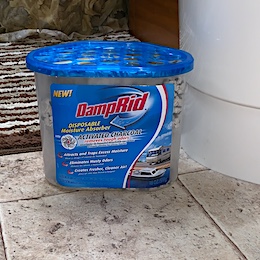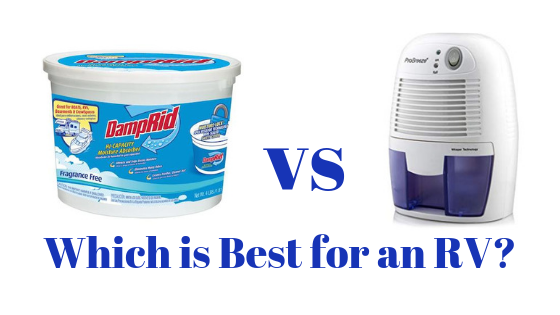Thanks for your support! If you make a purchase using our links in this article, we may make a commission. And, as an Amazon Associate, I earn from qualifying purchases. See the full disclosure here.
Updated April 9, 2024
Susan and I have spent some hot and humid days in Florida and Texas during summer. There is nothing worse than the feeling that everything in your RV is a little damp, especially your sheets and pillows! But, sometimes, running the AC isn’t enough to remove the humidity from the air inside your RV. So, what’s the best way to reduce the humidity? In this article, we examine Damprid vs dehumidifier to decrease humidity in your RV?
We keep DampRid in our RV year-round to help reduce the moisture in the RV. But I’ve seen this question about moisture in an RV come up repeatedly, and it made me wonder what would be the best way to reduce the humidity in my RV.
Of course, I did a little research to find the answer to DampRid vs. Dehumidifier—how to reduce humidity in an RV.
The quick answer is that a dehumidifier works better in a large open area with a lot of air exchange, like an RV. DampRid works better in a smaller closed-off area with restricted airflow, like a closet in an RV.
What are the Causes of Humidity in an RV?
There are many factors that can cause humidity or moisture to increase in an RV. Most people are aware that the general humidity in the air outside can increase the overall humidity, like on a hot, sultry summer day in Florida. But other factors can also increase the humidity level in your RV. They are:
- Breathing – every time we breathe out we increase the humidity inside the RV. It’s just like being in a car and watching the windows fog up. All that humidity comes from just breathing.
- Cooking – when we heat up our food moisture is released into the air.
- Showers – when we take a shower the steam increases humidity.
- Cleaning – when we wash the dishes moisture is released into the air from the hot water
- Drying Clothes or Towels Inside the RV – If you hang clothes or towels to dry inside your RV the moisture is released into the RV
- Automatic Dishwashers – For those awesome Class A’s out there, dishwashers heat the water and steam and moisture are released into the air during the drying cycle
All of these factors create moisture and in turn increase the humidity levels inside an RV. So, be sure to keep your RV properly vented in addition to using DampRid or a dehumidifier.
What is DampRid and How Does it Work?

DampRid is formulated to remove moisture from the air which can prevent excessive humidity, mold, and mildew. It contains a non-toxic, inorganic mineral salt called calcium chloride, sodium chloride, and potassium chloride. It looks like larger crystals of rock salt. Calcium Chloride is also used to melt snow and ice because it does less harm to concrete than salt.
DampRid works because the calcium chloride crystals attract and absorb moisture in the air. The moisture collected on the crystals forms water droplets that drip into the container’s bottom. You can place a container in your RV and watch the bottom fill up with water.
Then, empty the container and replace it with a new one. A large tub-sized container can typically last for about a month, depending on the humidity inside an RV.
Is Damprid Safe Around Children or Pets?
DampRid contains calcium chloride, sodium chloride, and potassium chloride. According to its website, these crystals are non-toxic and all-natural.
DampRid may cause irritation if it comes in contact with your eyes or skin, and it shouldn’t be inhaled. If you become exposed quickly rinse with soap and water. Because Damprid can cause irritation, some folks prefer not to use it around children or pets.
I’ve used calcium chloride many times as an ice melt on my driveway and I’ve had it all over my bare hands. All that ever happened to me was that my hands felt dry after I was done spreading it around. I then washed my hands with soap and water, with no side effects whatsoever.
How Does a Dehumidifier Work?
Dehumidifiers reduce humidity by removing moisture from the air. There are two methods dehumidifiers use, but we will focus on the most popular one, refrigerant-based dehumidifiers. So, how does a dehumidifier work?
A refrigerant-style dehumidifier works very simply. It works just like a cold glass of ice water on your kitchen table. The ice water in the glass is colder than the air outside of it, and condensation forms on the glass.
The water drops that form on the outside of the glass don’t come from the water inside the glass. They come from the water vapor in the air (aka humidity) around the glass. When the warm air touches the cold glass, the moisture in the air sticks to the outside of the glass and makes the water drop.
The same exact thing happens in a dehumidifier. Coils filled with refrigerants are colder than the air inside the RV. So when the air passes over the colder coils the moisture sticks to the cold metal coils and forms water drops.
The condensation then drips into a reservoir or holding tank at the bottom of the dehumidifier. You need to empty the holding tank daily so it doesn’t overflow.
Which is Better: Damprid vs Dehumidifier?
The answer is that a dehumidifier is better than Damprid in an RV. There are two primary reasons for this. The first is that in order for any dehumidifier to work, you need some airflow. Damprid creates no airflow, but a dehumidifier does. Second, the volume of air in an RV is too much for Damprid to be effective.
However, Damprid is great to use in areas inside an RV where airflow is restricted. For example, Damprid would work well in closets or under dinette bench seating where there is no air flow or ventilation.
Tips to Reduce Humidity in an RV
- Use the exhaust fan when taking a shower or cooking
- Cook outdoors if possible
- Don’t air dry clothes or towels inside the RV
- If the weather is dry open the windows
- Run the AC in hot weather
- Raise the air temperature in cold weather
- Run a fan to keep the air moving
- Use a dehumidifier
- Use DampRid
Pro Tip to Decrease Humidity in Your RV
We have a washer and dryer in our RV. One way we find to decrease the humidity in our RV is to put our towels and washcloths in the dryer after we shower.
This prevents the moisture in the towel from evaporating into our RV, while keeping our towels and washcloths smelling fresh.
Related Questions About Damprid vs Dehumidifier
1. Does Running the AC Reduce Moisture in an RV?
Yes, running the AC will help cool the air, and cool air can’t hold as much moisture, so the humidity will decrease. However, if you open the door to the RV often, cook inside the RV, wash the dishes and then take a shower, it will be very hard for the AC unit to keep up with the amount of moisture introduced into the RV. This is why most folks need a dehumidifier to help reduce humidity.
2. Can I Drink the Water Produced by a Dehumidifier?
Absolutely not! The water produced by a dehumidifier is clean but not clean enough to drink. You can use it to water house plants, but it is not suitable to water your vegetables or anything you might consume.
Although the water looks clean, it may contain lead, copper, aluminum, or zinc from the metal parts within the dehumidifier. The stagnant water in the holding tank may also cause mold.
Unlike distilled water, which is made sort of the same way a dehumidifier works, the water is not boiled first, which would kill bacteria and other pathogens.
Do you have any thoughts about how to reduce humidity in an RV? Please share your thoughts with us in the comments below!
Learn More:
– How to Find and Kill Mold in Your RV
– 15 Best RV Interior Cleaning Tips & Products
– How to Remove, Repair or Replace RV Interior Walls
Mike Scarpignato – Bio
Mike Scarpignato created RVBlogger.com over five years ago in 2018 to share all we have learned about RV camping.
Mike is an avid outdoorsman with decades of experience tent camping and traveling in his 2008 Gulf Stream Conquest Class C RV and 2021 Thor Challenger Class A motorhome.
We attend RV Shows and visit RV dealerships all across the country to tour and review drivable motorhomes and towable trailers to provide the best evaluations of these RVs in our blog articles and YouTube videos.
We are 3/4-time RVers who created RVBlogger.com to provide helpful information about all kinds of RVs and related products, gear, camping memberships, tips, hacks and advice.

If you would like to contact us directly please feel free to visit our Contact Page to send us an email.
To see a list of all of our articles check out the Blog Archive!



If you are off grid and do not have access to mains power or generator, how do you get the humidifier to work?
I keep a dehumidifier in my Class C and remove about a gallon and a half of water every day. It shuts off automatically when full and is usually shut off when I get around to emptying it everyday. I live in a humid climate and the humidifier is indispensable.
It might be worth mentioning similar benefits for boat interiors.
Hi Dave,
You just did!
I have never owned a boat so I don’t feel it would be appropriate for me to make boating recommendations. I try to stay in my lane and only share things I have done or products and services I have actually used myself.
I would guess humidity could be a big problem on a boat but I really don’t know.
Thanks for your comment.
Mike
We live in a humid climate. When we are not on the road, we keep the Damp-rid in the closed rv. On the road, we use the dehumidifier. I was amazed at how well the Damp-rid worked to remove the water. I will however add a second container to the rv in future when not in use, simply because the airflow is restricted as you said. It just makes more sense. Thanks for the excellent info.
Hi Joan,
Thanks for reading my article and for the kind words.
Mike
We use both Damprid and the Eva-Dry dehumidifier. We’ve had a better winter mostly because of the dehumidifier/Damprid combo!
Hi Christine,
That is great info!
Thanks for sharing!
Mike